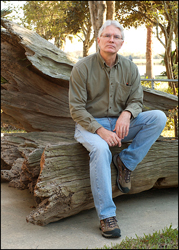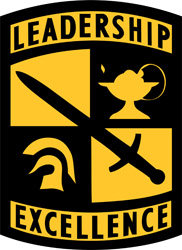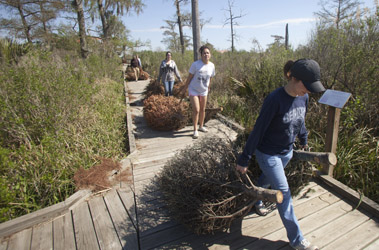|
Southeastern’s accreditation reaffirmed by SACSCOC
Southeastern’s application for reaffirmation of accreditation by the Southern Association
of Colleges and Schools Commission on Colleges (SACSCOC) was approved Monday (Dec.
7) at the SACSCOC annual meeting in Houston, university officials announced.
President John L. Crain said the SACS Board of Trustees voted to reaffirm the
university’s accreditation for another 10 years with no stipulations.
“This is the capstone accreditation for the university,” Crain said, “and I am
proud of the strong efforts of our faculty and staff who worked so hard to ensure
a successful outcome.” Southeastern has been accredited by SACSCOC since 1946.
Crain said Southeastern has been preparing its application for the last several
years. The application demonstrates how Southeastern meets high standards that cover
every aspect of the university, including its mission and governance, financial and
physical resources, institutional effectiveness, student services, faculty qualifications,
athletics, quality of educational programs and library resources.
Following a review by an off-site committee, an on-site Reaffirmation Committee
evaluated various documents, conducted inspections and interviewed faculty, staff
and students during a three-day visit last spring.
“The university is held responsible for clearly demonstrating and documenting
that we meet all standards and have the highest commitment to institutional integrity,
accountability and quality improvement,” Crain added.
The current review process requires completion of a self-study compliance audit
that addresses approximately 100 standards with significant documentation that each
standard is being met.
The review process also requires development of a quality enhancement plan (QEP)
that addresses an area designed to enhance student learning at the university. Southeastern
selected a “Real-World Ready” campaign designed to enhance opportunities for students
to practice skills in a setting authentic to their intended careers. Internships and
partnerships with businesses and agencies, service-learning courses, field experiences,
undergraduate research and other opportunities are all part of the experiential learning
process.
“These learning opportunities are current, pertinent, performance-based, and
practical applications of knowledge and skills experienced within the curriculum,”
Crain said. “The Real-World Ready campaign represents an exciting opportunity to enhance
student learning while also helping increase the university’s retention and graduation
rates, key factors in how universities are now being evaluated.”
|
|
 Southeastern professor authors short story collection Southeastern professor authors short story collection
Southeastern English Professor Norman German has published a new collection of short
stories.
Dead Dog Lying, a series of stories placed along the I-10 corridor from New Orleans to Texas, shines
a light on society’s misfits and is largely based on events the author has experienced,
dreamed or witnessed over his life. Many of the characters in the stories take their
names from towns along the corridor, such as Elton, Jennings, Iota, Cecilia and Henderson.
Norman said he dreamed about a boy with antlers and made him the protagonist
of “Deerboy,” whose title character gains the gift of athletic prowess. The story
“Controlled Burn” uses a prescribed ecological fire as the metaphor for a female game
warden’s barely controllable rage at her abusive father, on whom she exacts revenge
in a unique way at the story’s end. “The Girl and the Green Gas Can” is based on a
relative’s childhood predilection for sniffing gasoline until she passed out.
The tale “Ditchboy” is based on the real-life English girl Hayley Okines, who
died of progeria, the disease that prematurely ages its victims eight years for each
year they live. “She was 17 – or in ‘progeria years’ and thanks to new life-extending
drugs – 136 years old when she died,” he said.
“Norman German’s stories are filled with clever wordplay and witty turns of plot.
His expert use of description and metaphor demonstrates his longtime experience as
writer and teacher,” said Tim Gautreaux, Southeastern writer-in-residence and author
of “The Missing” and several other novels.
“In Norman German’s mesmerizing stories of south Louisiana, the ordinary is the
fantastic, and the fantastic becomes the everyday,” adds Gerald Duff, author of “Dirty
Rice and Blue Sabine.” “Horror and wonder live side by side in these powerful tales
of haunted states of mind. Dead Dog Lying takes hold and will not let go.”
A native of Lake Charles who earned his doctorate from the University of Southwestern
Louisiana (now University of Louisiana at Lafayette), German is the author of several
other works, including “A Savage Wisdom,” an imaginative reconstruction of the life
of Toni Jo Henry, the only woman executed in Louisiana’s electric chair; and the baseball
novel “Switch-Pitchers,” copies of which reside by special request in the Major League
Baseball Hall of Fame in Cooperstown, N.Y.
Dead Dog Lying was published by the University of Louisiana at Lafayette and is available through
the ULL Press, Amazon and other outlets.
|
|
Southeastern Nursing program ranked on ‘Top Value’ list
Southeastern’s online program that helps registered nurses earn their bachelor degrees
has been ranked among the nation’s top 50 most affordable online nursing programs
for 2016.
The program was ranked 22nd among 50 top accredited online nursing programs in
the U.S. by toprntobsn.com, which compares programs based on tuition and net cost. The Southeastern program
provides registered nurses, who may have an associate’s degree or diploma from a licensed
school, the opportunity to continue taking courses online, while earning credit toward
a bachelor’s degree.
“This ranking is intended to provide registered nurses with information about
affordable schools that meet their needs and help them fulfill their career aspirations,”
said Tim Otto, editor of “Top RN to BSN,” which publishes the rankings to help students
find the right college for their careers.
“We are pleased for the recognition that Southeastern has earned for offering
a strong and valuable opportunity for nurses seeking to advance their careers by earning
an undergraduate degree,” said Ann Carruth, dean of the College of Nursing and Health
Sciences. “The demands of careers in nursing increasingly require more advanced preparation.
In this program, we try to make every accommodation available to our students, while
maintaining our high level of quality instruction.”
Eileen Creel, School of Nursing department head, noted that higher educational
attainment in nursing usually translates to higher salaries and greater opportunities
for advancement.
Currently there are 90 active students enrolled in Southeastern’s RN-BS degree
program, said Creel. The program, which started in 2008, has seen more than 130 students
graduate with a bachelor’s degree.
Last year, the program was ranked among the top 50 best value RN to BSN programs
for 2015 by ValueColleges.com, a different online ranking of academic programs
Creel said in addition to a traditional undergraduate nursing school program,
where students receive clinical training at area hospitals and medical facilities,
Southeastern also offers a program for licensed practical nurses (LPNs) to attain
a bachelor’s degree, as well as an accelerated program for students already holding
a bachelor’s degree in any field.
Southeastern also offers master’s degrees and a doctorate in nursing practice,
which can be taken online.
|
|
|
ByLion takes a break
Today’s issue will be the last ByLion of 2015. ByLion will return on January 19,
2016.
Happy Holidays!
|
|
 Army ROTC courses return to Southeastern Army ROTC courses return to Southeastern
Southeastern will re-initiate its on-campus U.S. Army Reserve Officer Training Program
(ROTC) in the spring 2016 semester, university officials announced.
The program, originally started at Southeastern in 1969 during the Vietnam War,
was closed in 1995 due in large part to declining numbers and retrenchment by the
military as a result of budget constraints. More than a thousand students are estimated
to have gone through the program during those years.
The program is an enhancement of the partnership programs that developed with
LSU and Southern University in Baton Rouge after the Southeastern ROTC classes were
no longer offered on campus.
“We are pleased to re-introduce our students to ROTC military science classes
on the Southeastern campus. Increasingly, students are looking for options that include
military service, either for several years or as career,” said President John L. Crain.
“Southeastern’s previous experience with ROTC was successful in helping to prepare
future military leaders. We wanted to make this an easier option for those students
seeking to become officers.”
During the break in operations, Crain said Southeastern students were still able
to participate in ROTC, but had to take their military courses through Southern University’s
Navy program or LSU’s Army and Air Force programs. Participating Southeastern students,
however, had to travel to Baton Rouge in order to participate. This brings the program
back to Southeastern’s campus.
The university and the Army ROTC have started recruiting interested students
to enter the program next semester. For more information on the ROTC program, contact
admissions@southeastern.edu.
Gary Sandifer of Hammond, who entered the ROTC program in 1971 and is a founding
member of Southeastern’s ROTC Alumni Chapter, said he was excited to learn the university
was adding the program to its curriculum.
“Dr. Crain deserves a lot of credit for this; when he was convinced of the value
of ROTC, he put this project on the fast track,” Sandifer said.
ROTC Alumni Chapter President Steve Worth of Hammond also expressed his happiness
about the reinstatement decision.
“It was a great experience, and I’m glad to see Southeastern students will have
this option once again,” said Worth, who served 13 years in the Army as a Black Hawk
test pilot. “ROTC taught me a lot in the areas of leadership and how to work with
people.”
The ROTC Alumni Chapter has approximately 35 members and raises funds to provide
scholarships for ROTC participants.
Southeastern has been named a “Military Friendly School” by Victory Media four
times in the last several years for demonstrating its commitment to assisting active
and reserve military service members in a wide range of areas.
|
|
Southeastern to continuing recycling of Christmas trees to build up wetlands
 Southeastern will again collect used Christmas trees in partnership with area businesses
and government agencies as part of its annual Christmas tree collection effort designed
to enhance wetland restoration efforts in the Pass Manchac area. Southeastern will again collect used Christmas trees in partnership with area businesses
and government agencies as part of its annual Christmas tree collection effort designed
to enhance wetland restoration efforts in the Pass Manchac area.
Southeastern scientists at the university’s Turtle Cove Environmental Research
Station, located on Pass Manchac between lakes Pontchartrain and Maurepas, use the
discarded trees to help build up marshland in areas that have been impacted by erosion
and other factors, said Turtle Cove Manager Rob Moreau.
Partnering in the project for the second year is the Southeastern Sustainability
Center on North Oak Street, which will serve as a drop-off point for area residents
to leave their used Christmas trees. Other partners include the city of Hammond and
Middendorfs Restaurant in Manchac, as drop-off sites. In addition, Lowes in Hammond
again will donate unsold trees.
Trees can be dropped off beginning Dec. 26 through Mardi Gras from 7 a.m. to 3:30
p.m. at the Hammond Maintenance facility, 18104 Hwy. 190, next to Piggly Wiggly Super
Market. The Southeastern Sustainability Center, 2101 North Oak Street, will collect
trees beginning Jan. 5 through the end of the month from 7 a.m. to 4 p.m. Monday through
Thursday and 8 to 10 a.m. on Friday. Moreau said a Turtle Cove trailer drop off site
will also be maintained at Middendorfs Restaurant.
He said the City of Hammond will provide transport of collected trees to the Turtle
Cove Galva Canal parking lot area in Manchac where they will be stored until they
are deployed in the marshes.
No flocked trees will be accepted, and all trees should be stripped of any ornaments,
lights, tinsel and stands.
Rob Moreau said the trees will be used to continue a pilot project started last
year to determine whether the recycled trees can help fill in the logging ditches,
formed when the area’s cypress forests were cut down over a hundred-plus year span.
“The ditches allow salt water intrusion and increase the erosion process,” Moreau
said. “Under the supervision of biology researcher Dr. Gary Shaffer, we will place
trees in some selected ditches to determine if they can accumulate enough sediment
that might assist in filling them in. We’ll monitor and evaluate this process over
the next several years to determine its feasibility. If successful, this technique
could be used in other similarly stressed ecosystems in coastal Louisiana.”
Read more
|
|
Southeastern Police Department receives LHSC grant
The Southeastern Police Department has been awarded a $13,180 grant from the Louisiana
Highway Safety Commission (LHSC) to conduct additional traffic safety enforcement.
The primary goal of the grant is to reduce fatal and injury crashes on Louisiana
roadways, said Southeastern Lt. Patrick Gipson.
“Our students and employees travel the parish roads every day and often commute
from surrounding parishes,” he said. “We want everyone to arrive at their destinations
safely. That’s why we conduct highway safety enforcement.”
The grant provides funding for officers to work overtime conducting day and night
occupant protection and impaired driving enforcement. The University Police Department
will also participate in the LHSC and the National Highway Traffic Safety Administration’s
“Click It or Ticket” and “Drive Sober or Get Pulled Over” campaigns.
“Enforcement is only part of the effort,” explained Director of University Police
Harold Todd. “We will also collaborate with local partners, including Tangipahoa
– Reshaping Attitudes for Community Change (TRACC), Hammond City Police Department,
Tangipahoa Parish Sheriff’s Office, and Louisiana State Police, to educate our students
about safe driving habits.”
“Our efforts are part of a community-wide effort to save lives,” Todd added.
“If everyone works together and encourages their friends to drive safely, we can make
our parish roadways some of the safest in Louisiana.”
|
|